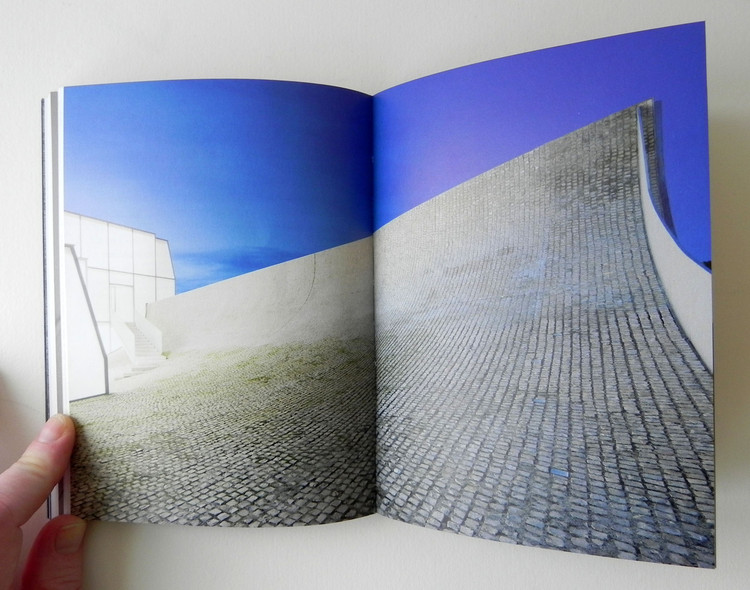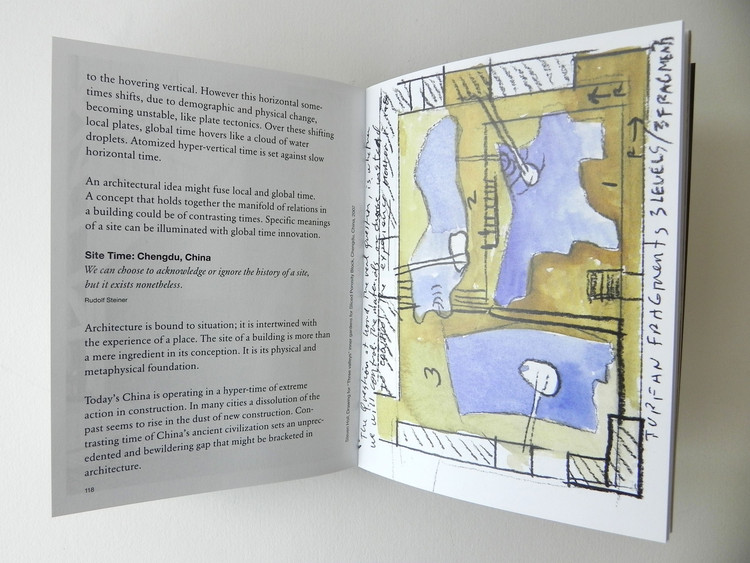
Last week, we received copies of two of Steven Holl’s newest publications, Scale and Color Light Time. Published by Lars Müller, the books examine Holl’s preoccupation with light and color as ways to inform the shaping of space. Holl’s architecture has consistently defined itself with formal gestures grounded in light and meaningful applications of textures and colors. While accurate to associate Holl with water color, the books shows the range such a medium has had over Holl’s career, as it has afforded the flexibility to serve as both an exploratory and explanatory tool.
More about the books after the break.
Upon unpacking the books, the first thing that caught our attention was the paper size and dimensions of both publications. Slightly smaller than 5 by 7 inches, the size of the thinner Color Light Time immediately says a lot for the book, as it is meant to serve as a quick reference or source of inspiration, and not collect dust on our libraries’ shelves.

Color Light Time begins with a short piece by Yung Hu Chang, a resident of Beijing, and the affects Holl’s Linked Hybrid has on his evenings. In a poetic manner, Chang describes the visible hints of life occurring inside the building, and the building’s ability of making him wonder who is walking through the corridors, or what he could be saying, etc. Chang comments upon how Holl’s creation has offered the polluted and chaotic life of Beijing a static reference point of idealism, he explains, “The intense colors under the bridges are either washed away by the sun or obscured by the polluted air. But the evening will certainly bring back the magic lanterns of architecture. Lights and colors will be waiting for me outside my windows when I return from work.”
For the Color portion of the book, Jordi Safont-Tria speaks of Holl’s color application and its connection to defining the visual harmony of the building. Holl is often affiliated with his beautiful water color renderings, yet, Safont-Tria’s chapter shares the time before the pastels, when Holl’s fascination with light and shadow was explored in an era of purely black-and-white renderings. “The forms of his watercolors have dissolved contours where lines and colors travel on the space of the paper creating spatial tensions between them. Most of his painting are investigations about volumes with different light and color properties without any other constraint: no scale, no gravity.”

The book has a great photo of Holl’s Horizontal Skyscrapper’s sixth elevation (a photo taken through the reflection pool at the base of the project). The photo is amazing as it allows us to understand Holl’s method of using natural elements to emphasize the inherent beauty of the architecture, and the relationship between the built and the natural. Safont-Tria explains, “Most of them introduce water as a phenomenal lens to reflect hues and shades of the environment or the facades. ..When a building’s soffit overlaps above a water plane, the mirror qualities of the latter create a chromatic space between the two horizontal layers.”

Sanford Kwinter’s contribution provides even more of a background on Holl’s use of water color and its branding implications for Holl. We love this strong quote by Kwinter, “To paint with water and pigment on a blotting surface, especially in the seventies and eighties when other architects worked either with penciled palimpsest, rapidograph on vellum, or with layered transparent films, was tantamount to a refusal to produce space in the ruled manner of the academic modernism – a refusal to see space as a synthetic product of rational…”

Kwinter also notes that the architect’s formal gestures cannot be calculated nor rationalized, “There is no equivalent in mathematics or even in architecture or art of Holl’s strange and indeterminate curves that follow static centers or regular arcs…they are the resultants that incorporate the friction of their trajectories through a medium that, in being encountered, must be displaced.”

Steven Holl concludes the book with his chapter on Time. Holl argues that architecture as an index can be measured in seven different times (diurnal, seasonal, linear, local site time, duction of conception/construction, experiential time and lastly, duration). Holl then pairs a project with each index of time as a way to show the index’s overlapping relations. Of the seven pairings, we enjoyed Holl’s site time explaination with his project for Chengdu, China as Holl explained that, “Architecture is bound to situation; it is intertwined with the experience of a place. The site of a building is more than a mere ingredient in its conception. It is its physical and metraphysical foundation.” The final chapter is a strong ending as Holl focuses on his architecture’s place in time and its broader implications on the site and the culture it resides.

Holl’s second book, Scale, is the perfect companion for Color Light Time. The book is a vast collection of Holl’s water colors (there are 33 projects ranging from 2001-2011), showing early ideas to more developed projects. On some pages, water colors are paired with completed projects to show the journey from concept to construction. Perhaps the most interesting are those showing Holl grappling with ideas of light connecting spaces or movement, and the form’s orientation. After reading Color Light Time, one views the water colors in Scale with a more analytical gaze and a deeper understanding of why and how Holl has chosen to express his ideas.







